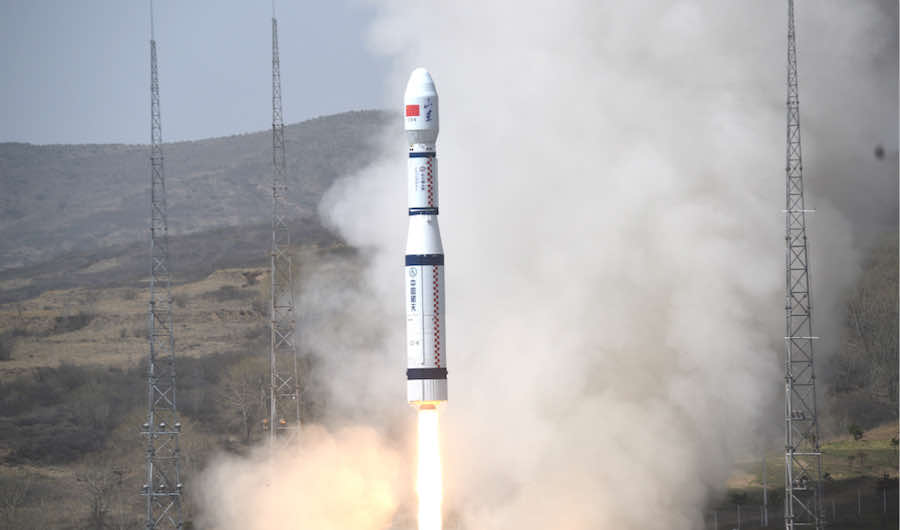
Nine small Chinese satellites, including a technology experiment to test out ways to capture space debris, rode a Long March 6 rocket into orbit April 27 on a rideshare mission managed by China Great Wall Industry Corp., the government-owned enterprise charged with selling Chinese launch services on the commercial market.
The fifth flight of a Long March 6 rocket lifted off from the Taiyuan space base in northern China’s Shanxi province at 0320 GMT April 27 (11:20 p.m. EDT April 26), according to China Aerospace Science and Technology Corp., the state-owned prime contractor for the Chinese space program.
The contractor, known as CASC, said in a statement that the mission was a “complete success” after the Long March 6 rocket deployed nine satellites into their targeted orbit. Publicly-released tracking data from the U.S. military indicated the launch delivered its payloads to a polar orbit about 310 miles (500 kilometers) in altitude, with an inclination of 97.4 degrees to the equator.
Designed to loft relatively small satellites into orbit, the Long March 6 is one of China’s newer rockets. The Long March 6 stands about 95 feet (29 meters) tall, and can haul a payload of up to 1,100 pounds (500 kilograms) to a sun-synchronous polar orbit a few hundred miles above Earth.
The Long March 6’s first stage is powered by a kerosene-fueled YF-100 main engine, a staged combustion powerplant Chinese engineers have worked on since 2000. The engine generates approximately 120 metric tons, or 264,000 pounds, of thrust. A YF-115 engine provides propulsion for the Long March 6 second stage.
The YF-100 and YF-115 engines are also used on China’s heavier-duty Long March 5 and Long March 7 rockets. The Long March 6’s third stage uses liquid-fueled thrusters for final orbital injection maneuvers before payload separation.
The payloads aboard the Long March 6 launch this week included two Earth observation satellites owned Shandong Institutes of Industrial Technology. The Qilu 1 and Qilu 4 spacecraft are designed for radar and optical imaging, respectively.
Qilu 1 will obtain all-weather remote sensing images of sites around the world, and also verify technologies for autonomous mission planning, on-orbit image processing, and inter-satellite laser communications, according to CASC. Qilu 4 will collect high-resolution optical imagery, aiding urban planning, agriculture, forestry, energy, and disaster mitigation efforts in Shandong province of northeast China.
Another small satellite, named Foshan 1, is an optical Earth observation test out an “ultra-lightweight camera design,” CASC said. Foshan 1 was developed by Cultivate Space Technology Co. for Jihua Laboratory.
Two more optical remote sensing satellites, Hangsheng 1 and Taijing 2-01, were developed by Hunan Hangsheng Satellite Technology Co., Ltd. and Beijing MinoSpace Technology Co., Ltd., according to CASC.
The NEO 1 spacecraft for a Chinese company named Origin Space will perform experiments aimed at validating technologies, such as a net, that might be used on future missions to capture and remove space junk from Earth orbit. The NEO 1 satellite will also observe small celestial bodies, presumably asteroids, CGWIC said in a press release.
The Tianqi 9 satellite that launched on the Long March 6 rocket joins a fleet of orbiting data relay stations designed for Internet of Things services. The Tianqi constellation is owned by Guodian Gaoke, a Beijing-based company.
The other two spacecraft on the Long March 6 launch were the Golden Bauhinia 1-01 and Golden Bauhinia 1-02 satellites. Both are remote sensing satellites developed by Beijing ZeroG Space Technology Co., Ltd.
Email the author.
Follow Stephen Clark on Twitter: @StephenClark1.